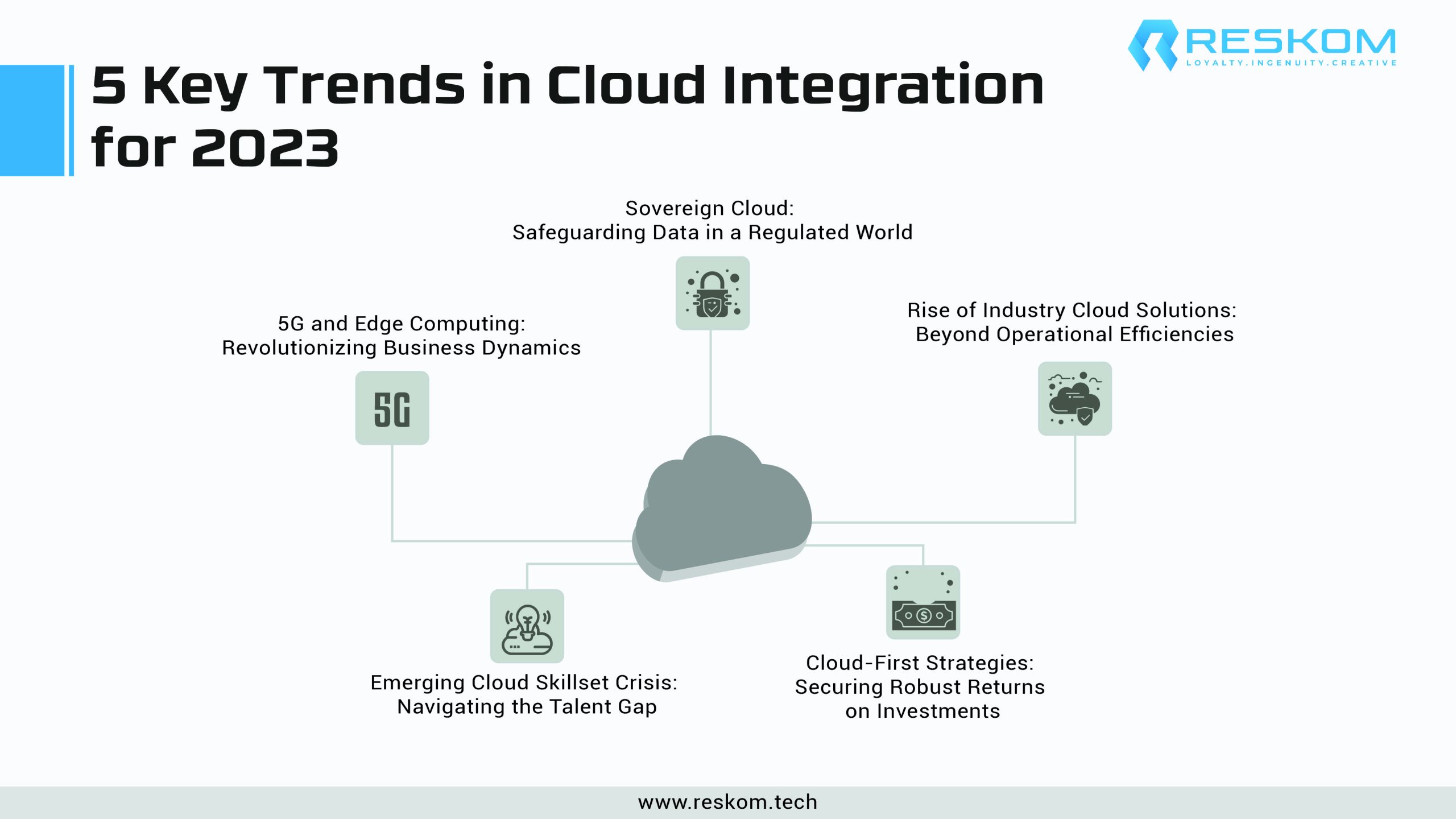The cloud stands as a strong force, driving innovation and reshaping the way businesses operate. As we step into 2023, the clouds are not only gathering data but also trends that promise to redefine the way we harness the power of the digital realm. In this blog, we will unravel the five key trends that are set to shape cloud integration in 2023, influencing industries, governments, and individuals alike.

1. Sovereign Cloud: Safeguarding Data in a Regulated World
The concept of sovereign cloud solutions emerges as a strategic shield against unauthorized foreign access. With more than 70% of countries enacting stringent data and privacy laws, enterprises are adapting by integrating sovereign cloud strategies into their multi-cloud, hybrid, and poly-cloud ecosystems. The rationale is clear – compliance with evolving regulations is not just a choice but an imperative strategy for 2023.
However, this move towards sovereign clouds comes with its own set of challenges. The complexity of system integrations and concerns about portability raise valid questions. Yet, the trade-off is clear – ensuring data sovereignty and compliance with regional regulations is non-negotiable. Navigating through this complexity will be a key focus for businesses in 2023.
2. 5G and Edge Computing: Revolutionizing Business Dynamics
The integration of 5G and edge computing technologies is set to revolutionize the operational dynamics of businesses. This powerful duo promises to optimize data storage and computation, unleashing a wave of possibilities from sustainability solutions to in-store customer experiences. The cloud, with its ability to process data closer to the source, is becoming a game-changer in frontline business operations.
As we embark on this journey of digital transformation, we can’t overlook the concurrent rise of quantum computing, artificial intelligence, machine learning, and immersive technologies like virtual and augmented reality. These technologies are not only expanding the horizons of cloud computing but also embedding it deeper into our everyday lives.
3. Rise of Industry Cloud Solutions: Beyond Operational Efficiencies
2023 is set to witness an explosion of industry-specific cloud solutions. From overhauling supply chain management to pioneering sustainability initiatives, these tailored solutions offer more than just backend operational efficiencies. Consumer-facing industries like retail and hospitality are positioned to leverage edge computing for immediate benefits, translating into tangible improvements in key performance indicators (KPIs).
This trend signifies a shift from generic cloud solutions to specialized, industry-focused adaptations. The ripple effect of this shift will be felt across sectors, showcasing the return on investment (ROI) of targeted cloud investments. It’s not just about storing data in the cloud; it’s about crafting solutions that resonate with the unique needs of each industry.
4. Emerging Cloud Skillset Crisis: Navigating the Talent Gap
As cloud technologies continue to evolve, they bring forth a new set of skill requirements. The demand for multi-cloud architects is rising, creating a talent gap that needs immediate attention. Enterprises, governments, academia, and industry bodies must join forces to address this skillset crisis. Training, retraining, and retaining talent must become top priorities for businesses aiming to turn their cloud-powered visions into reality.
Despite economic headwinds and budget scrutiny, projections indicate an increase in cloud spending, especially in the medium to long term. The innovations and collaborations unfolding in the cloud space are delivering services that are becoming increasingly vital for global businesses. The challenge now lies in building a workforce equipped with the skills to navigate this evolving landscape.
5. Cloud-First Strategies: Securing Robust Returns on Investments
Organizations that proactively adopt ‘cloud-first’ strategies will be significantly better positioned to secure robust returns on their investments. The cloud is not just a storage solution; it’s a dynamic force that, when harnessed strategically, can propel businesses into the future. As we navigate through sovereign clouds, embrace 5G and edge computing, and tailor solutions for specific industries, the essence lies in viewing the cloud as an enabler rather than a reactive necessity.
Demystifying Sovereign Cloud Solutions: What It Means for Businesses
Sovereign cloud solutions might sound like a complex term, but at its core, it’s about securing your digital space. It’s not just about following rules but creating a shield for your data in the vast digital landscape.
Supercharging Your Business with 5G and Edge Computing
Imagine your business operations getting a turbo boost – that’s the promise of 5G and edge computing. In straightforward language, we explore how these technologies work together to make things faster and smarter. From quicker data processing to enhancing customer experiences, the exciting possibilities that 5G and edge computing bring to the table.
Tailored Cloud Solutions: Why Your Industry Deserves Its Own Cloud
Industries aren’t one-size-fits-all, and neither should their cloud solutions be. The idea of industry-specific cloud solutions shows why it’s like having a customized toolkit for your business. Whether you’re in retail, hospitality, or any other field, learn how these tailored solutions go beyond just making things efficient – they make them uniquely yours.
Cracking the Talent Code: Why Cloud Skills Matter
It’s not just about storing data in the cloud; it’s also about having the right people who know how to make the most of it. There’s a buzz about cloud skills, breaking down the talent gap and why businesses need to invest in their workforce. In simple terms, discover how having the right skills can turn your cloud-powered dreams into reality.
Cloud-First Strategies: A Roadmap to Success
Closing the blog with a practical approach, why adopting a ‘cloud-first’ strategy is more than just a buzzword. It’s about being proactive, not reactive. Using straightforward language, we uncover the essence of this strategy – how it’s not just a trend but a roadmap that can lead businesses to secure robust returns on their cloud investments.
Conclusion
As we say goodbye to the conventional rules of cloud computing, 2023 takes us into a realm of possibilities. The trends outlined here are not just phases but permanent in shaping the future of digital integration. The cloud is no longer a distant thing but an integral part of our present and future. Navigating through sovereign clouds, riding the wave of 5G and edge computing, embracing industry-specific solutions, and addressing the talent gap are not mere challenges but opportunities for growth and innovation. Data is king, mastering the art of cloud integration is the key to unlocking the doors to a digitally empowered tomorrow.
RESKOM offers the best cloud integration for all your professional needs. Do contact us for all your cloud integration needs.


